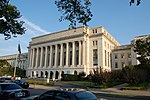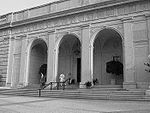Farm Service Agency

The Farm Service Agency (FSA) is the United States Department of Agriculture agency that was formed by merging the farm loan portfolio and staff of the Farmers Home Administration (FmHA) and the Agricultural Stabilization and Conservation Service (ASCS). The Farm Service Agency implements agricultural policy, administers credit and loan programs, and manages conservation, commodity, disaster, and farm marketing programs through a national network of offices. The Administrator of FSA reports to the Under Secretary of Agriculture for Farm Production and Conservation. The current Administrator is Richard Fordyce. The FSA of each state is led by a politically appointed State Executive Director (SED).
Excerpt from the Wikipedia article Farm Service Agency (License: CC BY-SA 3.0, Authors, Images).Farm Service Agency
Jefferson Drive Southwest, Washington
Geographical coordinates (GPS) Address Website Nearby Places Show on map
Geographical coordinates (GPS)
| Latitude | Longitude |
|---|---|
| N 38.888055555556 ° | E -77.03 ° |
Address
Jamie L. Whitten Building (Jamie Whitten Bldg.)
Jefferson Drive Southwest
20250 Washington
District of Columbia, United States
Open on Google Maps











